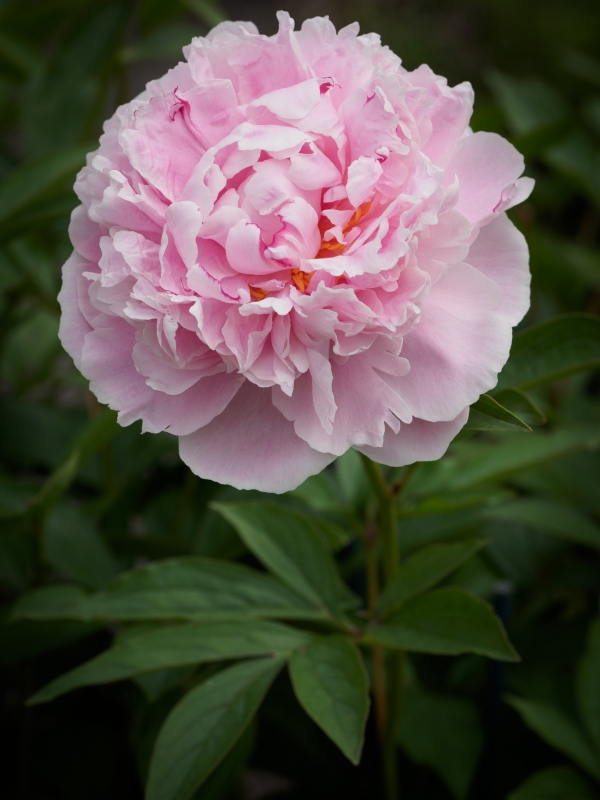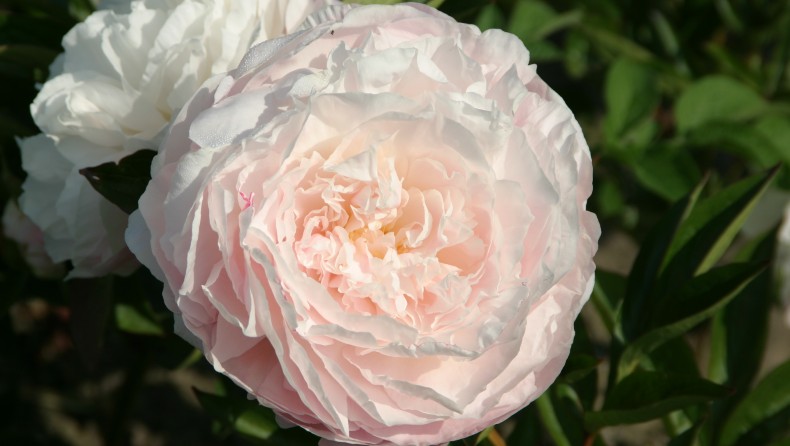Paeonia
Paeonia or peonies are long lived, spectacular, showy plants that flower usually from May to June. They are some of the most sought after plants for gardeners. In this article we look at some of the most popular forms and have included images of a few of the plants we grow on the nursery.


'Sarah Bernhardt' 'Bowl of Beauty' 'Duchess de Nemours'
Paeonia Lactiflora. This fascinating species of Peony, is popular as a garden plant and has been in cultivation from the 7th Century in China. Originally grown for its medicinal properties, it became popular in the Imperial palace gardens and inspired many artists to replicate its sumptuous looks in paintings, wall hangings and sculptures. The Chinese gardeners started crossing them and came up with beautiful new cultivars. The large, fragrant blooms make wonderful cut flowers and although slow to establish, healthy specimens are very long lived and can produce up to a hundred flowers each season. P. lactiflora were introduced into the UK in about 1850 and rose to prominence just after the turn of the 18th century. Their popularity has not diminished since.



'Primevere' 'Mother's Choice' 'Starlight'
The flowers of this type of Peony are made up of one, two or more rings of petals surrounding a central mass of petaloid structures. The leaves are large, glossy and dissected and will often give rise to wonderful Autumn colour before dying back in the Winter. Many of them will grow quite well un-staked, but some of the heavier forms will need individual supports inserted under each flower bud. The open flowers are a big draw for pollinators. Be aware that they contain a substance that can be harmful if ingested by animals, but they are not listed as toxic to humans.
P. officinalis. This plant has been found in European gardens for about five hundred years and along with P. lactiflora has been the parent to many of the most popular herbaceous cultivars we see today. The reddish pink flowers are comprised of a single or double ring of large outer petals and a central cluster of golden yellow anthers over divided leaves. They are often seen in older properties and rarely need staking. These are also completely deciduous and have been divided into four subspecies because there are subtle differences in the plant, from each region where it grows in Europe.
The crossing of these two types of Peony began in earnest in Europe, with France becoming the most prolific producer of new plants. Many examples were immortalised in the paintings of the impressionists.
P. lutea & P. suffruticosa Our next type is the Tree Peony (suffruticosa and lutea) which has stout woody stems and can grow up to 6 ft tall in old money or 1.8m. As a result they can produce even more flowers than the herbaceous types. They prefer slightly more sheltered positions (out of the wind, but plenty of light) and will normally flower a little later. Old wood will produce new buds the following spring so prune carefully to an outward facing bud to encourage side shooting and more flowers. The flowers are large and the foliage is finer and more delicate in appearance. Hot Summers seem to encourage the production of more flower buds the following year.
Itoh Peony Finally, we come to the wonderful intersectional Peonies or Itoh hybrids. These are named after Dr Toichi Itoh, from Japan, who succeeded, in what was thought to be impossible, by crossing the tree Peony (P. lutea) with P. lactiflora. The result was a magnificent plant that had strong stems and long-lasting blooms of the highest quality. These are the most expensive of the Peonies, but are worth it. They are more tolerant of cold that their tree Peony relative and have the more compact habit of the herbaceous forms. They flower later than herbaceous forms thus allowing you to extend the flowering season into the Summer. Many will produce a second flush of flowers so deadheading is beneficial. Do not feed with a nitrogen rich fertiliser, but use feed with low levels of nitrogen such as seaweed, well rotted manure (with no smell) or leaf compost. Intersectional or Itoh Peonies produce new growth each season from ground level so you should cut old stems back to approx. 6 inches or 15cm from the ground. They do best in situations that provide at least some shade during the day. As with all of their kind, they like rich fertile soil.



'Bartzella' 'First Arrival' 'Cora Louise'
A couple of others to consider are firstly the very famous ‘Molly the Witch’ (P. mlokosewitchii) which lends itself to shadier spots and is great in dappled, woodland sites but it will also tolerate more sun. The grey, green foliage is flushed pink as it emerges earlier in the Spring than many other types, and is followed by soft yellow flowers with a central cluster of richer yellow anthers.
P. mlokosewitchii 'Molly The Witch'
Finally, we come to another of the 33 recorded species, Paeonia tenuifolia. This relatively small form (approx. 2 ft or 60cm) comes from the Russian Steppe so is very cold tolerant in Winter and can also take hot, dry Summers. It has beautifully soft fern like foliage and deep shiny red flowers. The foliage and flowers appear much earlier than other herbaceous types and it will also die down earlier. There are cultivars with different coloured flowers available. If you collect seeds from this plant, sow them directly onto the surface of the soil as they need light to germinate.

Paeonia tenuifolia
Planting When planting Peonies it is imperative that they are planted shallowly, failure to do so will give rise to lots of foliage and little or no flowers. I suspect that this issue gave rise to the old wives tale ,that you cannot move these wonderful plants. You can, just do it when they are dormant and never replant any deeper in the soil than they were before. The rule to follow is that the roots need to be just below the surface of the soil and the toes (upward growing shoots) should be allowed to peek through early in their growth cycle. Peonies can be split by dividing the roots when the clump gets large, each root section should have at least one toe.


